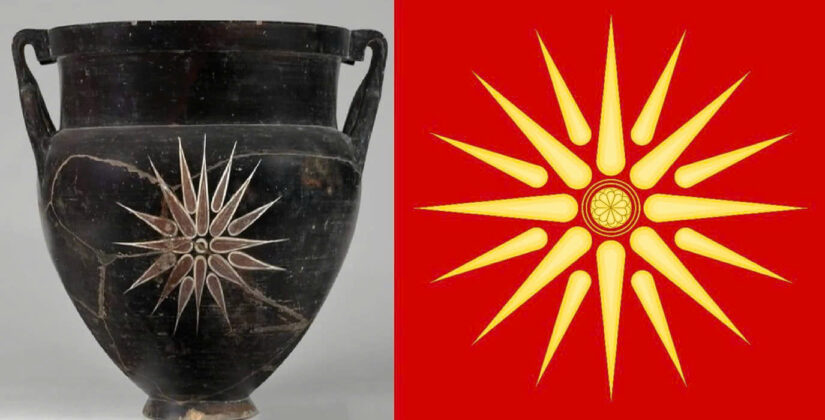Within the grand and revered halls of the Louvre Museum in Paris resides the Panhellenic Sun, a magnificent artifact that captures the profound cultural significance of ancient Greek symbols. This extraordinary 6th-century BC crater, originating from the city of Sparta, is adorned with the iconic Vergina Sun, a radiant emblem featuring 16 striking rays. Notably, this artifact predates the rise of Macedonia as a dominant force within the Greek world, emphasizing its broader Panhellenic importance and transcendent cultural value.
The Vergina Sun, while often associated with the ancient Macedonian dynasty, represents much more than mere decoration on this piece of Spartan pottery. Its prominent placement on the crater suggests that this symbol held deep meaning long before it became linked exclusively with Macedonia. This association indicates that the Vergina Sun may have been a shared cultural emblem, resonating across various Greek city-states and especially among the Dorian tribes of Sparta and their northern counterparts in Macedonia. The presence of this symbol on Spartan craftsmanship sheds light on its widespread recognition and shared significance within the ancient Greek world.

Sparta, renowned for its military prowess and disciplined societal structure, exhibited cultural traits that echoed across other Dorian regions. The Vergina Sun’s appearance on this artifact hints at a profound connection between these areas, suggesting that the symbol represented not just local identity but a more extensive Panhellenic unity. It serves as a reminder that the Greek city-states, despite their frequent rivalries and differences, shared symbols, traditions, and ideas that traversed their boundaries. The crater provides a rare glimpse into the interconnectedness of ancient Greece, where cultural exchange fostered a collective Hellenic identity, uniting disparate regions under shared heritage and values.
The Vergina Sun’s significance becomes even more compelling when viewed in the context of Spartan culture. Known for its austere lifestyle and dedication to military excellence, Sparta also valued the preservation and promotion of its cultural symbols. The inclusion of the Vergina Sun on this crater suggests that the emblem held a unifying power, embodying ideals of strength, unity, and continuity that resonated throughout the Dorian world and beyond. As such, the artifact represents not only a work of exceptional craftsmanship but also a bridge connecting diverse Greek communities through shared cultural symbols.
Today, the Panhellenic Sun’s legacy extends far beyond its ancient origins. It is recognized internationally as a Hellenic symbol and is protected under the auspices of the World Intellectual Property Organization (WIPO). This modern acknowledgment underscores its enduring relevance as both a cultural artifact and a representation of Greek heritage. The 16-rayed sun has evolved into a universal emblem of unity, pride, and connection to the ancient Greek world, transcending time to symbolize the enduring legacy of Hellenic culture.
The Spartan crater housed in the Louvre is more than an artifact of historical and artistic significance; it serves as a poignant reminder of the cultural richness and symbolic depth of ancient Greece. It celebrates the artistic achievements of its creators while reflecting the shared symbols that have long helped define Greek identity. This particular piece, with its depiction of the Vergina Sun, highlights the power of shared cultural expressions in fostering a sense of unity among the city-states of ancient Greece.
The broader implications of the Vergina Sun’s role in Greek culture cannot be overstated. By examining its presence on artifacts like this Spartan crater, historians and archaeologists gain valuable insights into the ways ancient Greeks viewed themselves and their relationships with neighboring regions. The symbol’s repeated use across different city-states suggests a cultural cohesion that extended beyond local affiliations, reflecting a collective identity that bound the Greek world together. This shared identity, embodied in symbols like the Vergina Sun, laid the foundation for the Panhellenic unity that would later define much of Greek history.
Moreover, the Panhellenic Sun’s enduring relevance speaks to the timeless nature of cultural symbols. In today’s world, where national and cultural identities often intersect and overlap, the continued recognition of the Vergina Sun highlights the importance of preserving and celebrating shared heritage. Its protection under WIPO emphasizes the value placed on such symbols as a means of connecting past and present, fostering a sense of continuity that links modern societies with their historical roots.
The artistic merit of the Spartan crater also deserves special recognition. The craftsmanship and attention to detail evident in this artifact are testaments to the skill and creativity of its creators. The precise rendering of the Vergina Sun, with its symmetrical rays radiating outward, exemplifies the technical expertise and aesthetic sensibility of ancient Greek artisans. Such works not only served functional purposes but also conveyed profound cultural and symbolic messages, underscoring the interconnectedness of art, identity, and society in ancient Greece.
As the Panhellenic Sun continues to shine brightly in the modern era, it serves as a symbol of the enduring legacy and glory of the ancient Greek world. Its presence in the Louvre stands as a testament to the cultural achievements of ancient Greece, offering a window into a civilization that valued unity, creativity, and shared identity. For visitors to the museum, the Spartan crater provides a tangible connection to this rich heritage, inviting reflection on the ways in which symbols shape and define the human experience.
In conclusion, the Panhellenic Sun, as represented by the Vergina Sun on the Spartan crater, embodies the timeless values of unity, pride, and cultural connection that defined the ancient Greek world. Its significance, both in antiquity and in the present day, underscores the enduring power of symbols to unite people across time and space. Housed within the Louvre Museum, this remarkable artifact continues to inspire and educate, reminding us of the shared heritage that binds humanity together. The Vergina Sun’s rays, shining as brightly today as they did over two millennia ago, illuminate the rich tapestry of history and the unbroken threads of cultural continuity that define the Greek legacy.





